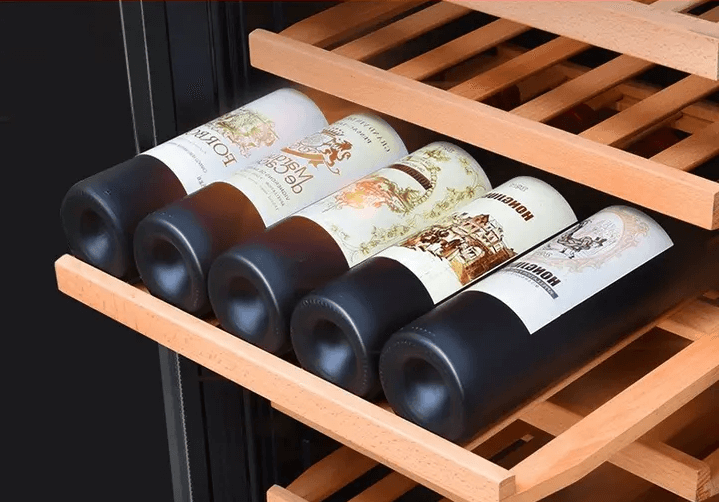When it comes to storing your cherished wine collection, the right storage conditions are essential. Wine enthusiasts often invest in wine fridges to ensure their bottles are kept at the perfect temperature and humidity level. But do wine fridges need ventilation, and what role does it play in preserving your wine? In this article, we'll explore the importance of ventilation in wine fridges and how to ensure your wine is stored properly.

Understanding the Basics
Ventilation 101: Ventilation in wine fridges is crucial to maintaining the right temperature and humidity. Proper ventilation allows for the circulation of air within the fridge, preventing temperature imbalances and mold growth.
Cooling Process: Wine fridges use a cooling system to regulate the internal temperature. This cooling process generates heat, which needs to be expelled to maintain the desired temperature inside the fridge.
Signs of Poor Ventilation
Temperature Fluctuations: One of the telltale signs of poor ventilation is inconsistent temperature within the wine fridge. Some areas may be too warm, while others are too cold.
Mold Growth: Without adequate ventilation, the humidity level can become imbalanced, leading to mold growth on corks and labels.
Ventilation Requirements
Rear Ventilation: Many wine fridges are designed with rear ventilation. It's essential to leave enough space behind the fridge to allow heat to dissipate. Typically, a few inches of clearance are sufficient.
Built-In Units: Built-in wine fridges often have ventilation at the front or base, and these should be unobstructed to ensure proper airflow.

Tips for Ensuring Ventilation
Clear the Surroundings: Ensure there are no obstructions around the wine fridge. Objects placed too close can impede proper airflow.
Avoid Overcrowding: While it's tempting to fill your wine fridge to capacity, overcrowding can hinder ventilation. Maintain some space between bottles.
Ventilation and Humidity Control
Ideal Humidity: Wine fridges should maintain a humidity level of around 50-70%. Proper ventilation helps in humidity control, preventing excessive dryness or moisture buildup.
External Humidity Control: Some wine fridges come with humidity control features to ensure optimal conditions for your wine. This can be particularly useful in dry climates.
Regular Maintenance
Cleaning and Maintenance: Regularly clean the condenser coils and fans to ensure proper ventilation. Dust and debris can accumulate, affecting the fridge's efficiency.
Check the Seals: Properly sealed doors are essential for maintaining temperature and humidity. Check and replace seals if they show signs of wear.
Read more: How to Maintain and Clean Wine Cooler?(part 1)
Common Wine refrigerator Issues and Maintenance Methods (Part 2)
Common Wine Refrigerator Maintenance Questions and Answers(Part 3)
Seek Professional Assistance
If in Doubt: If you're unsure about the ventilation requirements of your wine fridge or if you notice persistent issues, consult the manufacturer's guidelines or seek professional assistance.
Ventilation in Wine Cellars: If you have a wine cellar, ensure it's well-ventilated. Proper air circulation is vital for large storage spaces.
In conclusion, wine fridges do indeed require ventilation to maintain the ideal storage conditions for your wine collection. It's essential to understand the specific ventilation needs of your wine fridge model and follow best practices to ensure your wine stays in perfect condition.
FAQs
1. Can I place my wine fridge next to other appliances like a dishwasher or oven?
Answer: It's best to avoid placing your wine fridge next to appliances that generate heat, as this can affect its cooling efficiency.
2. How often should I clean the condenser coils in my wine fridge?
Answer: Cleaning the condenser coils every six months is a good practice, but more frequent cleaning may be necessary in dusty environments.
3. Is it possible to add additional ventilation to my wine fridge if it lacks proper airflow?
Answer: While it's possible, modifying your wine fridge should be done with caution and may void the warranty. Consult the manufacturer or a professional technician.
4. What is the ideal temperature for wine storage in a wine fridge?
Answer: The ideal temperature for wine storage is typically between 45°F to 65°F (7°C to 18°C), depending on the type of wine.
5. Can I use a regular refrigerator for wine storage if I don't have a wine fridge?
Answer: While it's possible, regular refrigerators are generally too cold for wine storage and lack the proper humidity control, which can harm the wine.







